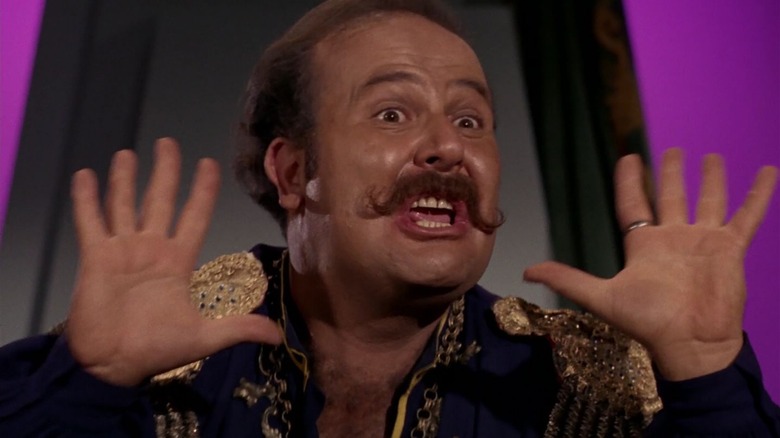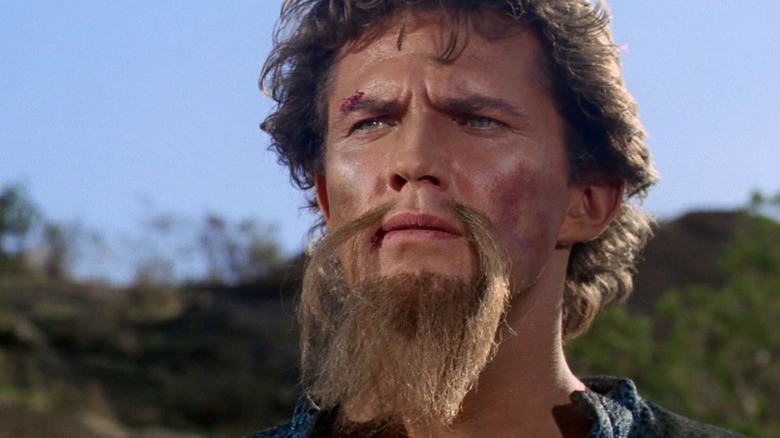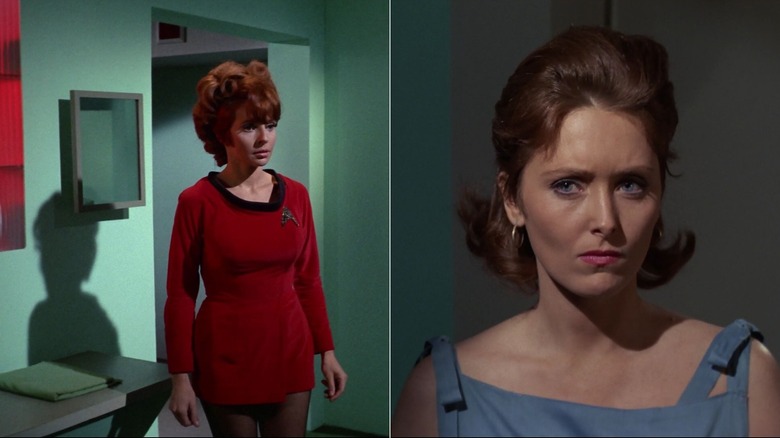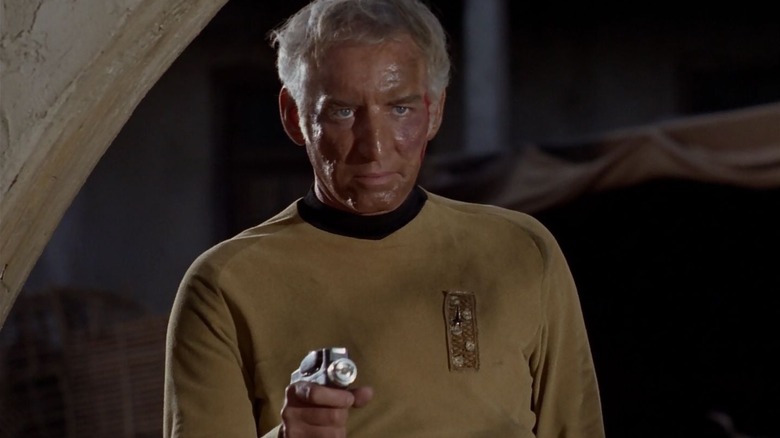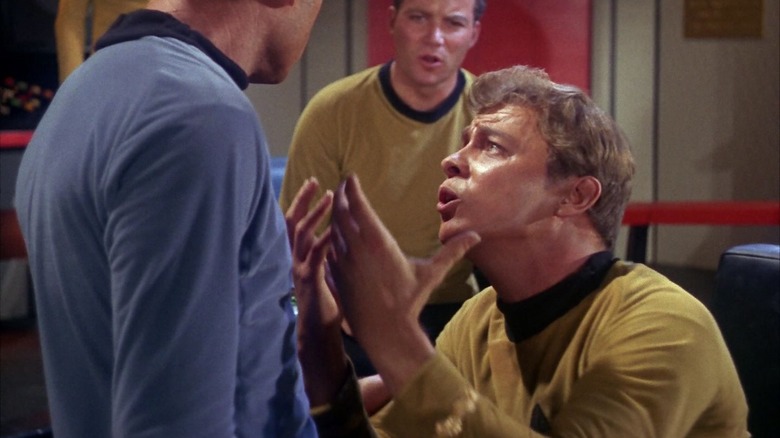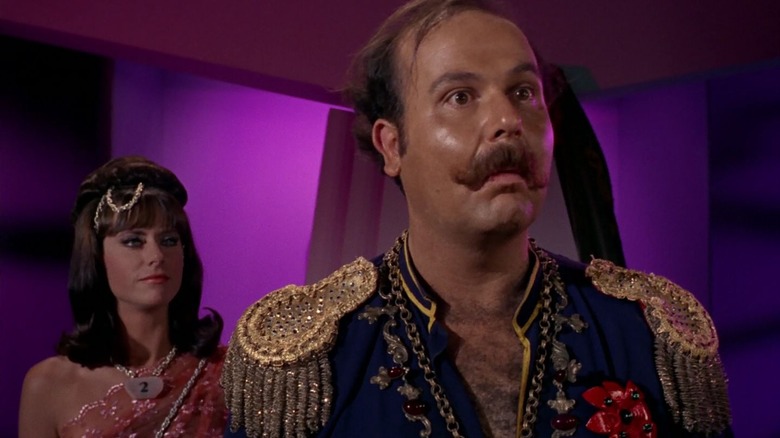The 5 Most Hated Characters On Star Trek: The Original Series
"Star Trek" is a workplace drama first and foremost, and it took place on board the well-organized U.S.S. Enterprise, a space vessel carefully divided into necessary departments, offices, and workstations. The main characters were, by necessity, deeply professional, and tended to keep their upper lips stiff as they faced unusual spatial phenomenon or aggressive alien visitors. Very occasionally, one of the main characters would lose their cool, make a foolish decision, or have an unexpected freakout, but for the most part, level heads prevailed. Many love the central cast of "Star Trek" for their ability to remain capable under pressure, and it's hard to hate someone when we understand they're so good at their job.
There were many characters throughout "Star Trek," though, that never had their wits about them. Indeed, there were whimsical agents of chaos, whiny incompetents, and corrupt captains that felt counter to the egalitarian spirit of "Star Trek," sometimes to the point of feeling like a betrayal. Indeed, while "Star Trek" often presented itself as a progressive show about a pacifist future, there were still weirdos who worshiped dictators and women who resented their own gender. "Star Trek" wasn't always as progressive as it could have been, even with the values of the 1960s.
Below are some of the worst characters to flit through "Star Trek," adding nothing to the fabric of the universe, nor enriching viewers with their unique points of view. The below characters, in most cases, were just embarrassing. Read on to discover the five (well, six) worst characters on the original "Star Trek," ranked from least-worst to most-worst.
5. Lazarus (Robert Brown) from 'The Alternative Factor'
"The Alternative Factor" (March 30, 1967) was recently selected by /Film as one of the five worst episodes of the original "Star Trek," and it's easy to see why. It's nonsensical and incompetent, filmed so poorly, a viewer often can't even tell what's going on. The story revolves around Lazarus (Robert Brown), a mysterious interdimensional traveler who seems to be slipping in and out of our dimension. The sight of Lazarus is enough to elicit titters, as his silly spirit-gummed-on beard would look fake in a high school play.
It's eventually explained that Lazarus is passing through a tube-like rift in between dimensions. When he passes through it, however, he encounters a crazed doppelgänger, and the two of them engage in a slow-motion, over-photographed fistfight. The alternate Lazarus then arrives in our dimension to explain everything all over again. The two Lazaruses are supposed to be opposites, with one crazed and the other rational, but they never emerge as distinct beings. Also, their little bouts of interdimensional pugilism appears to be ripping holes in the spacetime continuum.
The characters both appear irrational, the reason for their constant fighting remains unclear, and surely at least one of them would want to stop fighting the other if all of reality was at stake. Instead, we have two screaming, silly villains who are ultimately sealed in a pocket dimension to wail on each other for eternity. Good. It's what they deserve.
4. (tie) Lieutenant Marla McGivers (Madlyn Rhue) from 'Space Seed' and Dr. Janice Lester (Sandra Smith) from 'Turnabout Intruder'
"Star Trek" is often presented as open-minded and progressive, but with these two characters, one can see just how regressive the series could be.
In "Space Seed" (February 16, 1967), the Enterprise finds the cryogenically frozen body of former tyrant Khan Noonien Singh (Ricardo Montalbán), a charismatic dictator left over from Earth's darkest period of 21st century war. Khan, having missed nearly 200 years of history, is assigned a historian, Lieutenant Marla McGivers (Madlyn Rhue) to guide him into the present. McGivers isn't just interested in history, however. She fetishized it to a dangerous degree. She comes to admire Khan, and even mutinies against Captain Kirk (William Shatner) when he pressures her and negs her and treats her terribly. She is a wilting flower, and hardly seems to be a good example of Starfleet professionalism. Marla will end up leaving the Enterprise with Khan.
In "Turnabout Intruder" (June 3, 1969), the final episode of the series, all kinds of sexist conceits are dropped into "Star Trek" lore. Most Trekkies tend to ignore "Turnabout Intruder," as it stated, in dialogue, that women were not allowed to be starship captains because they're too "hysterical." In the episode, Dr. Janice Lester (Sandra Smith) uses a high-tech device to switch bodies with Kirk, and uses his identity to usurp the Enterprise. In Kirk's body, she constantly proves the episode's sexist point, shrieking and behaving rashly at every turn. Dr. Lester was a character used to prove that women are incapable, and men are stern and able. It's a pretty gross character in what might easily be the worst episode of the show.
3. Captain Ronald Tracey (Morgan Woodward) from 'The Omega Glory'
"The Omega Glory" (March 1, 1968) is a pretty stupid episode, too. In it, Kirk and co. beam down to the planet Omega IV to find a civil war raging between tribes called the Yangs and the Kohms. The war is being perpetuated by a mad captain named Ronald Tracey (Morgan Woodward) who lost most of his crew to a debilitating disease. He thinks the Yangs or the Kohms have a cure, as they live for thousands of years. Tracey is a classic example of a Starfleet captain gone bad, as he deliberately continues a civil war for his own purposes. One can easily see Tracey as a stand-in for the United States during the Vietnam War.
But additional plot twists rip apart that metaphor. It seems that Omega IV, many years earlier, was developing parallel to Earth, and had even had its own versions of the American Pledge of Allegiance, an American Flag, and a U.S. Constitution. Just by coincidence, mind you. Kirk and Spock (Leonard Nimoy) find that the named "Yangs" and "Kohms" are bowdlerized abbreviations of "Yankees" and "Communists." It's the dumbest Cold War parable imaginable.
The twists also reveal Captain Tracey to be little more than a battle-hungry dunderhead. He wants to perpetuate a civil war, and hopes to find a cure for a disease, but he comes across as unthinking, mad, and sweaty. His presence doesn't help the story, and his character is callow and weak-willed. Gee, what a wonderful, memorable, dynamic character.
2. Lieutenant Bailey (Anthony Call) from 'The Corbomite Maneuver'
Lieutenant Bailey (Anthony Call) was the first legitimately terrible officer audiences got to see on "Star Trek." In "The Corbomite Maneuver" (November 10, 1966), the Enterprise is visited by a massive sphere-shaped ship called the Fesarius. The unseen captain of the Fesarius boasts his power and wants to destroy the Enterprise for trespassing in his space. Kirk, thinking quickly, negotiates a cease-fire and keeps his crew alive by bluffing. He claims that Federation starships are equipped with a substance called Corbomite which will reflect any attack back at the attacker. The Enterprise would be destroyed, but so would the Fesarius. It's a tense situation, but Kirk is quick-thinking enough to prevent violence from breaking out.
Perhaps included to serve as a counterpoint to Kirk's level head is the whiny, horrible Lieutenant Bailey, who questions every one of Kirk's orders, and who freaks out when something might possibly go wrong. While it might have been dramatically important for Kirk to have a sounding board, Bailey is hardly one to match wits. All he does in complain and even potentially put the Enterprise at risk. Early in the episode, viewers likely hope that Spock will knock him out with a Vulcan neck pinch and let the adults take care of the situation.
At the very least, Bailey eventually chills out enough to take a tour of the Fesarius when it's revealed that its captain Balok (Clint Howard) is actually peaceful and friendly. No one asked me, but it seems that Bailey might not be the best diplomat to initiate talks with Balok.
1. Harcourt Fenton 'Harry' Mudd (Roger C. Carmel) from 'Mudd's Women' and 'I, Mudd'
As mentioned above, the main characters on "Star Trek" tend to be calm and professional at all times. As such, when one wants to invent a comedic counterpoint, one would logically invent an irreverent and irresponsible character like Harcourt Fenton "Harry" Mudd (Roger C. Carmel). Mudd is lascivious, greedy, sinister, and always looking for a quick buck. In his two episodes — "Mudd's Women" (October 13, 1966) and "I, Mudd" (November 3, 1967) — Mudd seems particularly keen on sex trafficking. In the former episode, Mudd wants to sell a few mail-order brides to distant miners, and keeps the women young by feeding them youth drugs. Younger women, he rationalizes, fetch higher prices. Gross, man.
Then, in the latter episode, Mudd finds himself in charge of a subterranean planet of androids, and it's implied that he's been boning the bots. More importantly, Mudd had a robot clone of his wife constructed specifically so he could turn her off when she starts nagging him. It's embarrassing that "Star Trek" had to stoop to a "nagging wife" joke.
Harry is meant to be a comedy figure, a wildly inappropriate procurer meant to stand opposite a stalwart character like Kirk. Carmel does his best, but Harry Mudd just isn't funny. He's too busy being sexist and awful to elicit titters. Mudd would return for "Star Trek: The Animated Series" and would play a major role in the first season of "Star Trek: Discovery." Perhaps one episode should have been enough. Or maybe even less than one.
